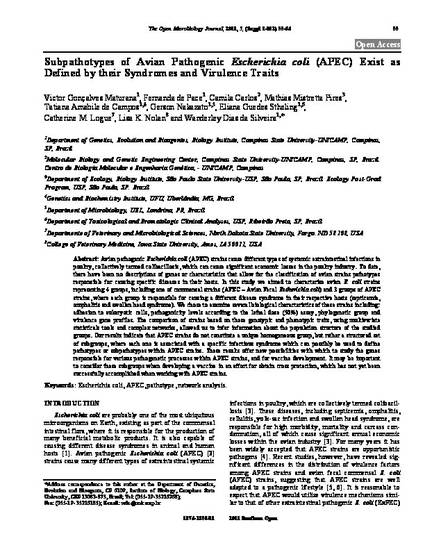
Article
Subpathotypes of Avian Pathogenic Escherichia coli (APEC) Exist as Defined by their Syndromes and Virulence Traits
The Open Microbiology Journal
Document Type
Article
Disciplines
Publication Date
7-20-2011
DOI
10.2174/1874285801105010055
Abstract
Avian pathogenic Escherichia coli (APEC) strains cause different types of systemic extraintestinal infections in poultry, collectively termed colibacillosis, which can cause significant economic losses in the poultry industry. To date, there have been no descriptions of genes or characteristics that allow for the classification of avian strains pathotypes responsible for causing specific diseases in their hosts. In this study we aimed to characterize avian E. coli strains representing 4 groups, including one of commensal strains (AFEC – Avian Fecal Escherichia coli) and 3 groups of APEC strains, where each group is responsible for causing a different disease syndrome in their respective hosts (septicemia, omphalitis and swollen head syndrome). We chose to examine several biological characteristics of these strains including: adhesion to eukaryotic cells, pathogenicity levels according to the lethal dose (50%) assay, phylogenetic group and virulence gene profiles. The comparison of strains based on these genotypic and phenotypic traits, using multivariate statisticals tools and complex networks, allowed us to infer information about the population structure of the studied groups. Our results indicate that APEC strains do not constitute a unique homogeneous group, but rather a structured set of subgroups, where each one is associated with a specific infectious syndrome which can possibly be used to define pathotypes or subpathotypes within APEC strains. These results offer new possibilities with which to study the genes responsible for various pathogenetic processes within APEC strains, and for vaccine development. It may be important to consider these subgroups when developing a vaccine in an effort for obtain cross protection, which has not yet been successfully accomplished when working with APEC strains.
Rights
This is an open access article licensed under the terms of the Creative Commons Attribution Non-Commercial License (http://creativecommons.org/licenses/
by-nc/3.0/) which permits unrestricted, non-commercial use, distribution and reproduction in any medium, provided the work is properly cited.
Copyright Owner
Maturana et al.
Copyright Date
2011
Language
en
File Format
application/pdf
Citation Information
Victor Gonçalves Maturana, Fernanda de Pace, Camila Carlos, Mathias Mistretta Pires, et al.. "Subpathotypes of Avian Pathogenic Escherichia coli (APEC) Exist as Defined by their Syndromes and Virulence Traits" The Open Microbiology Journal Vol. 5 Iss. Suppl 1 (2011) p. 55 - 64 Available at: http://works.bepress.com/lisa_nolan/36/

This article is from The Open Microbiology Journal 5, suppl 1 (2011): 55–64, doi:10.2174/1874285801105010055.